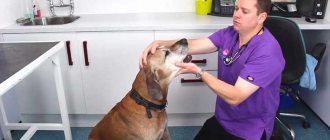There are a number of diseases that, it would seem, do not pose a threat to the dog’s life and are, rather, a cosmetic problem. These diseases include papillomas - tumors of benign origin. However, warts (as papillomas, which are growths on the skin, are popularly called) are far from harmless and pose a serious threat to animal health.
Causes of the disease
The mechanism of pathology development is as follows. Papillomavirus (PV) penetrates the most sensitive cells of the basal layer through cracks in the skin or oral mucosa.
In the affected area, the virus begins to rapidly multiply and reproduce new layers of harmful cells, which actively replace healthy ones. In this way, the papillomavirus invades the basal cells, actively moving towards the surface epithelium.
The infected cell, moving towards the surface, stops dividing, which provokes the virus to stimulate the metabolism and reproduction of the captured cell with transforming proteins.
This, in turn, leads to active cell division, their unlimited growth and transformation into tumor cells. This process leads to the appearance of papillary tumors on the skin or mucous membrane - papillomas. As they grow, they visually become similar to cauliflower.
The virus is unusually stable and persists in the external environment for a long time, so the main reason for the development of the disease is contact with sick individuals, as well as through various care items.
Also, the most likely causes of the pathology include weak immunity and long-term therapy with corticosteroid drugs.
Caring for a sick dog
Adherents of traditional medicine advise using:
- garlic;
- spurge;
- dandelion;
- celandine;
- dry ice;
- rowan;
- linen threads and other options.
Wart in a dog
The use of such methods increases the risk of developing fibrosarcoma, and the use of folk remedies on the mucous membrane of the eye can permanently deprive the pet of vision.
After removing the tumor, wait for complete healing. Treat the area with medications recommended by your doctor until the crust falls off on its own. As a rule, dietary adjustments are not required, but in case of damage to the oral cavity, it is better to temporarily switch to soft and liquid foods.
During treatment and care, purchase a special collar.
In it, the dog will not be able to lick off the ointments used.
Main symptoms
Papillomas are small cone-shaped neoplasms of a soft and loose consistency, localized mainly on the oral mucosa, less often on the abdomen, paws, vulva and other parts of the body.
At the initial stage, the nodules have a smooth, even surface and a pinkish tint. As the disease progresses, papillomas become dirty gray in color and have jagged edges.
The size of warts varies, sometimes they can reach the size of a bean. Since papillomas are equipped with blood vessels, they are easily damaged and bleed.
Tumors can cause severe discomfort for your dog. It hurts her to chew and swallow, making it difficult to eat. An unpleasant odor emanates from the mouth. The animal refuses to eat, becomes lethargic, and subsequently becomes exhausted.
Can the infection be transmitted to humans?
There is no convincing scientific evidence for this. However, this is hypothetically possible, because more than six hundred strains of human papillomavirus are known that can mutate and change.
- Therefore, it is possible that some of them can become universal, parasitizing both the human body and the animal body.
- If you have a papillomatous dog in your home, we recommend that you carefully observe personal hygiene and properly treat wounds and scratches.
Diagnostics in a veterinary clinic
Diagnosis includes taking an anamnesis and examining the animal. If papillomas are located in the oral cavity, the veterinarian will detect them immediately. It’s another matter when tumors are formed on the pads and in hard-to-reach places, for example, on the vulva. A dog's thick, long hair can also hinder diagnosis.
To obtain the most complete and reliable information about papillomas, in particular, for detailed immunohistochemical examination, determination of the virus and the presence or exclusion of oncology, biopsy samples will be required. If it is difficult to determine the type of pathogen, PCR (polymerase chain reaction) is used.
A diagnostic method such as electron microscopy can make an accurate diagnosis, but, unfortunately, not every veterinary clinic is equipped with expensive equipment for its implementation.
Surgical method
Specialists in veterinary clinics are reluctant to perform the surgical method. This is explained by the fact that after the procedure there is a risk of papillomas spreading to other parts of the body. However, sometimes this is the only way to relieve the dog of discomfort.
Basic methods of surgical treatment
- cryodestruction - neoplasms are frozen using liquid nitrogen;
- burning out papilloma using high-frequency electric current;
- use of laser.
The last method is the safest. However, not every animal clinic can afford such high-precision and expensive equipment.
Treatment method and prognosis
There is no single treatment for papillomas in dogs. For each specific case, the doctor develops an individual scheme based on the dog’s age, health, the nature of the tumor and other factors.
There are cases when papillomas disappear on their own, but if they do not disappear for a long time and grow rapidly, then treatment cannot be avoided.
The most common treatment method is surgery. Types of operations to remove papillomas are as follows:
- cryosurgery - removal of warts by exposure to low temperatures;
- electrocoagulation - removal by electric current;
- laser therapy;
- surgical excision with a scalpel.
Laser removal is a painless and effective method that does not require anesthesia. However, surgical excision is often preferred, since a scalpel can be used to remove growths even in hard-to-reach places. The operation is performed under general anesthesia, as are cryosurgery and electrocoagulation.
The decision regarding the type of operation is made by a specialist. Most often, puppies, young dogs whose age does not exceed 4 years, and individuals with weakened immune systems are exposed to it. For elderly animals over 10 years of age, surgery is performed for medical reasons.
Drug therapy is not as effective as surgery, but sometimes it gives good results, especially if the disease is diagnosed at an early stage. The dog is prescribed immunomodulators, injections of novocaine solution, and the drug “Fosprenil”.
If you go to the veterinary clinic in a timely manner and undergo treatment, the specialists’ prognosis is favorable.
Vaccination
Annual vaccination will help protect against the appearance of papillomavirus. It is carried out under sterile conditions.
- To make it, papillomatous tissue from the affected area is used.
- The injection is performed subcutaneously twice.
- The interval between sessions is 7-10 days.
- Improvements are observed after three weeks.
What to do at home
Many owners prefer to treat papillomas in dogs using traditional methods, without seeking help from specialists. Meanwhile, self-medication is dangerous for your pet’s health and can lead to serious consequences. Traditional methods can be used, but only after consultation with a veterinarian and in combination with conservative therapy (if treatment is medicinal).
You can lubricate warts with celandine juice. The juice that flows near the root of the medicinal plant is used. Over time, the tumor will begin to turn black, after which it is carefully cut off, while treatment of the affected area should continue. Over time, the tumor disappears.
Garlic, dandelion juice, acetic acid, ice, and raw berry mixture have also proven themselves well.
Prevention Tips
Extremely important in prevention
This viral disease, papillomatosis, is to maintain a strong general immune system. Then, if the dog gets sick, spontaneous recovery will quickly occur. To do this, follow the principles of balanced nutrition and proper pet care. It is also necessary to monitor the condition of the skin and the appearance of tumors. Do not allow your dog to come into contact with an individual with papillomatosis. Strengthen your immune system with physical activity and vitamin supplements. If your dog has papilloma, protect it from infections and do not let it chew or scratch it.
The 24-hour veterinary service at the “I am VET” center will become your faithful assistant in the treatment and prevention of any pathologies in four-legged pets. Prices for services and medications are lower than in many other veterinary hospitals, see for yourself by calling our center! At the same time, we are steadily increasing the experience and professionalism of our staff, taking care of the growth of qualifications and training of employees.
Doctors who come to your call will bring with them the necessary medications, equipment, documents and work permits. At home, your pet will quickly recover, and you can always turn to us for help and advice, since the doctor remains in touch even after the animal has recovered. Do not self-medicate skin diseases in your dog, but contact the specialists of our center!
Preventive measures
One of the main methods of preventing papillomatosis today is animal vaccination. Pet hygiene and the cleanliness of all equipment for its care also play a huge role. Properly selected housing conditions and a balanced diet rich in vitamins and minerals will significantly reduce the risk of animal disease.
Prevention methods:
- Systematic examination of the animal’s body for the presence of neoplasms;
- Limiting your pet’s contact with strange, unfamiliar dogs;
- Walks in the open air;
- If warts are found, minimize the risk of your dog scratching or picking them off.
It is important to remember that only a professional can provide high-quality effective therapy, so you should not try to treat animals yourself using questionable methods. If papilloma is detected in your pet, you should contact a veterinarian as soon as possible, and you should also carry out preventive examinations in a timely manner.











